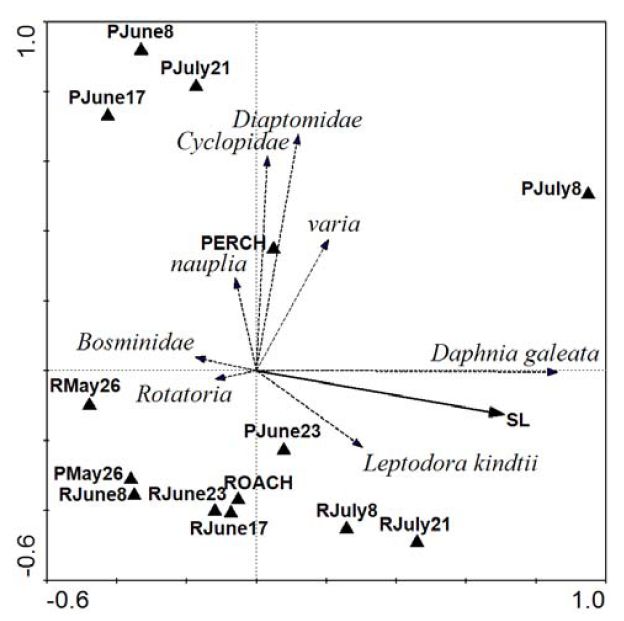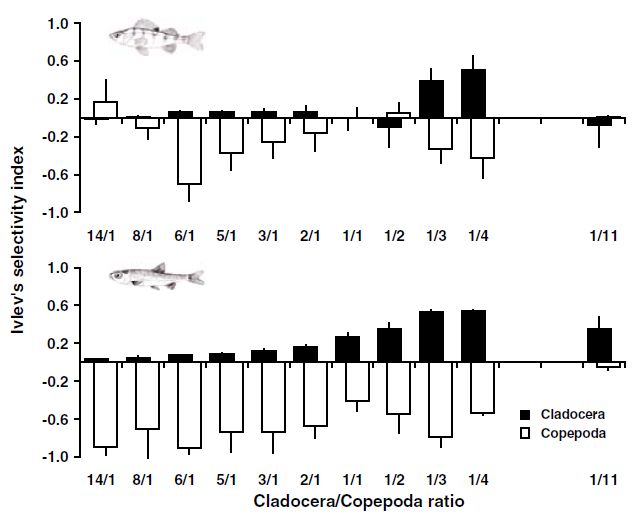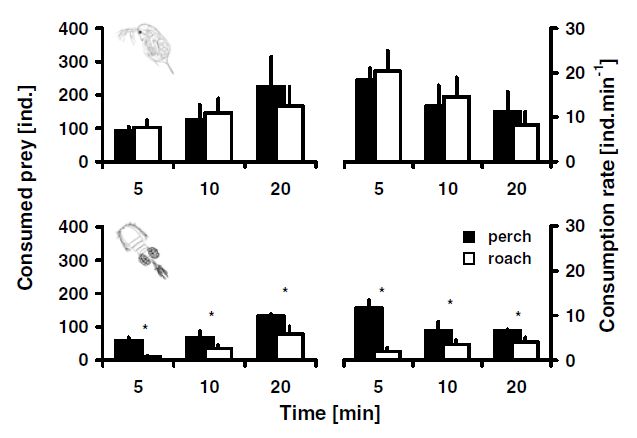 Feeding selectivity and efficiency of young-of-the-year European perch and roach were compared under field and laboratory conditions. In laboratory experiments, the importance of prey evasiveness versus prey movement conspicuousness for fish selectivity was evaluated with respect to changing Cladocera/Copepoda prey ratio. Feeding efficiency was additionally investigated in relation to feeding time (5, 10, 20 min) and prey density (approx. 50, 200, 700 ind. L−1). In Římov Reservoir, the diet of both fish species was nearly exclusively composed of crustacean zooplankton. In roach, diet shifted from rotifers and bosminids in May, towards Daphnia sp. and Leptodora kindtii in June and July. Daphnia contributed almost exclusively to the roach diet since June, composing on average more than 94% of total prey. Cyclopoid copepods, occurred in the roach’s diet only on the first sampling date; later on both cyclopoid and calanoid copepods were completely absent. On the other hand, copepods played an important role in the diet of perch. In early and mid-June when their share in the zooplankton was particularly high, copepods contributed by more than 50% to the diet of perch. Although their contribution dropped with their decline in zooplankton in June/July, by the end of July they again comprised about one third of perch’s diet. In both fish species, the increase in numbers of cladocerans in their diet was related to increase in SL. In roach, the numbers of consumed prey were doubled every twenty days during the investigated period. In perch the increase was not so consistent, but significantly higher efficiency of perch was reported on three out of six sampling dates. In laboratory experiments, roach showed a distinct avoidance for copepods and a preference for cladocerans. Both prey categories were only fed non-selectively when they dominated the prey mixture. Perch selectivity was more diversified. Contrary to roach, perch were fed copepods non-selectively on a balanced prey ratio. Further, with an increasing share of Cladocera, a situation resembling that of roach and Copepoda was avoided. However, when the share of copepods in the prey mixture dropped below ten percent, they were consumed non-selectively and with their ongoing decline in the prey mixture their preference even increased. Feeding efficiency differed significantly between perch and roach when foraging on copepods exclusively or on a prey mixture where copepods predominated. In the short time feeding experiment (5 min) with copepods, perch consumed on average 5.9 times more prey than roach. Although roach increased their success with increasing time it was still 1.7 times greater than for perch in the long time feeding experiment (20 min). Total numbers of prey consumed were positively affected by prey density and feeding time. With increasing feeding time, the consumption rate generally declined. With a fourfold increase in feeding time, the numbers of consumed prey increased on average only two times. Only in roach feeding on copepods did the numbers of prey consumed per minute of feeding increase with increasing feeding time. However, the overall numbers were low. Differences in feeding selectivity and efficiency between perch and roach juveniles were found to be significant both in the field and laboratory experiments. In roach, selectivity was determined solely by prey evasiveness. By contrast, perch’s selectivity was influenced by prey movement conspicuousness; prey escape abilities did not play an important role. Perch were more efficient foragers on evasive prey, but its feeding efficiency for non-evasive prey was not lower than that of roach. According to our observations, we suggest feeding behaviour to be responsible for the roach’s inefficiency in capturing evasive copepods.
Feeding selectivity and efficiency of young-of-the-year European perch and roach were compared under field and laboratory conditions. In laboratory experiments, the importance of prey evasiveness versus prey movement conspicuousness for fish selectivity was evaluated with respect to changing Cladocera/Copepoda prey ratio. Feeding efficiency was additionally investigated in relation to feeding time (5, 10, 20 min) and prey density (approx. 50, 200, 700 ind. L−1). In Římov Reservoir, the diet of both fish species was nearly exclusively composed of crustacean zooplankton. In roach, diet shifted from rotifers and bosminids in May, towards Daphnia sp. and Leptodora kindtii in June and July. Daphnia contributed almost exclusively to the roach diet since June, composing on average more than 94% of total prey. Cyclopoid copepods, occurred in the roach’s diet only on the first sampling date; later on both cyclopoid and calanoid copepods were completely absent. On the other hand, copepods played an important role in the diet of perch. In early and mid-June when their share in the zooplankton was particularly high, copepods contributed by more than 50% to the diet of perch. Although their contribution dropped with their decline in zooplankton in June/July, by the end of July they again comprised about one third of perch’s diet. In both fish species, the increase in numbers of cladocerans in their diet was related to increase in SL. In roach, the numbers of consumed prey were doubled every twenty days during the investigated period. In perch the increase was not so consistent, but significantly higher efficiency of perch was reported on three out of six sampling dates. In laboratory experiments, roach showed a distinct avoidance for copepods and a preference for cladocerans. Both prey categories were only fed non-selectively when they dominated the prey mixture. Perch selectivity was more diversified. Contrary to roach, perch were fed copepods non-selectively on a balanced prey ratio. Further, with an increasing share of Cladocera, a situation resembling that of roach and Copepoda was avoided. However, when the share of copepods in the prey mixture dropped below ten percent, they were consumed non-selectively and with their ongoing decline in the prey mixture their preference even increased. Feeding efficiency differed significantly between perch and roach when foraging on copepods exclusively or on a prey mixture where copepods predominated. In the short time feeding experiment (5 min) with copepods, perch consumed on average 5.9 times more prey than roach. Although roach increased their success with increasing time it was still 1.7 times greater than for perch in the long time feeding experiment (20 min). Total numbers of prey consumed were positively affected by prey density and feeding time. With increasing feeding time, the consumption rate generally declined. With a fourfold increase in feeding time, the numbers of consumed prey increased on average only two times. Only in roach feeding on copepods did the numbers of prey consumed per minute of feeding increase with increasing feeding time. However, the overall numbers were low. Differences in feeding selectivity and efficiency between perch and roach juveniles were found to be significant both in the field and laboratory experiments. In roach, selectivity was determined solely by prey evasiveness. By contrast, perch’s selectivity was influenced by prey movement conspicuousness; prey escape abilities did not play an important role. Perch were more efficient foragers on evasive prey, but its feeding efficiency for non-evasive prey was not lower than that of roach. According to our observations, we suggest feeding behaviour to be responsible for the roach’s inefficiency in capturing evasive copepods.
Keywords: Cyclopidae; Daphnia; Diaptomidae; foraging ecology; juvenile fish; Leptodora kindtii; movement pattern apparency


